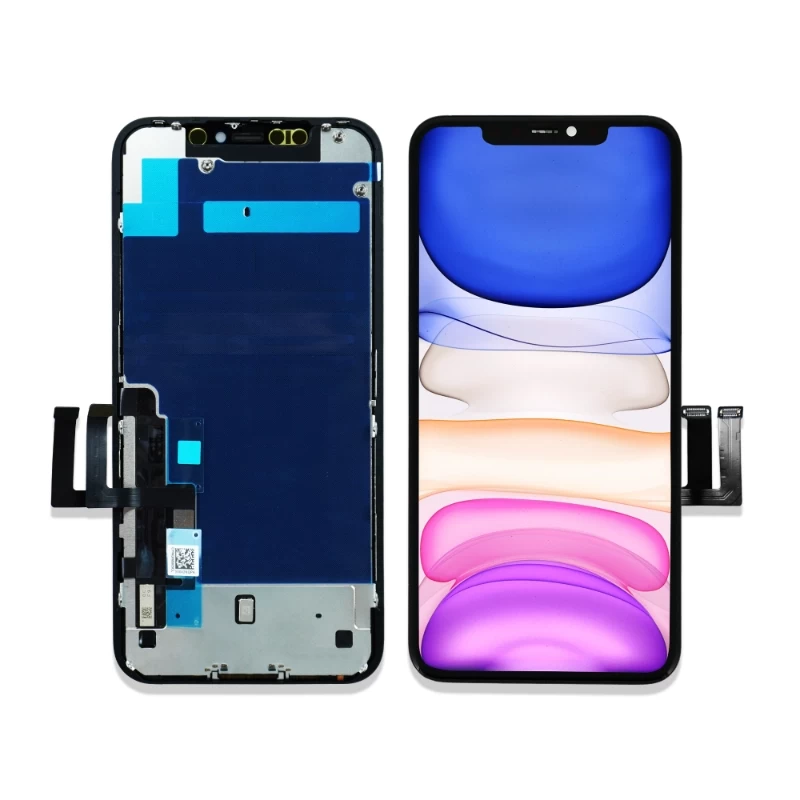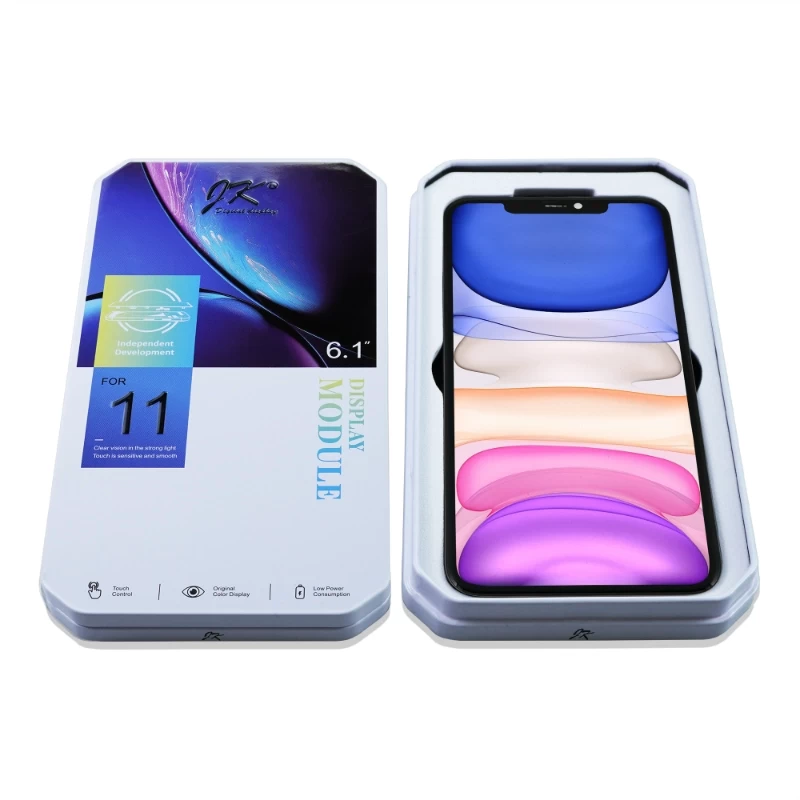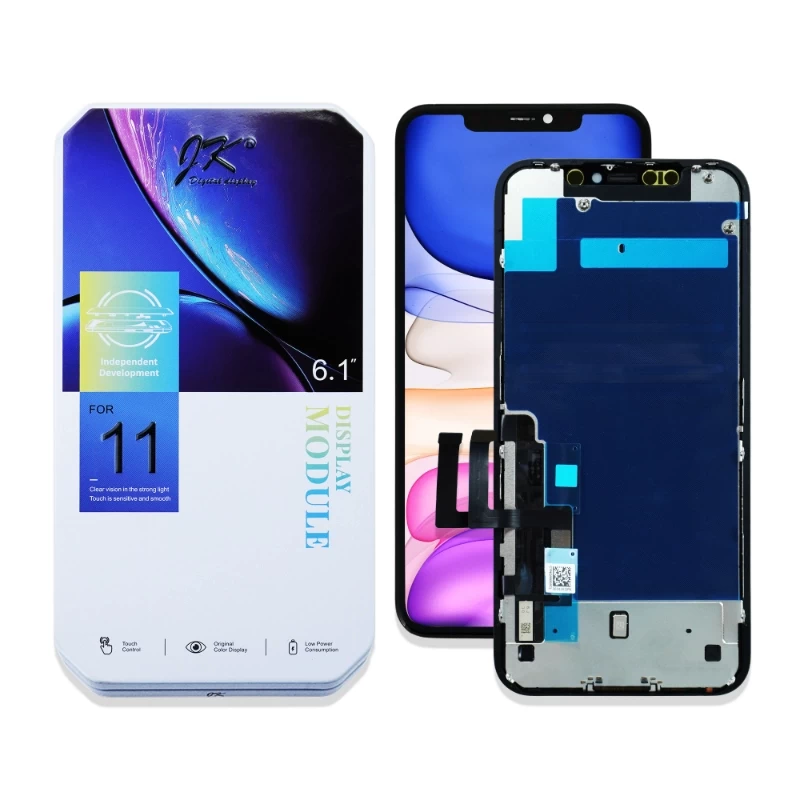The iPhone 11 has taken the smartphone world by storm with its sleek design and impressive features. One of the standout components of this device is its LCD display screen. In this article, we will delve into the intricacies of the JK iPhone 11 LCD display screen, exploring its slim profile and stunning performance that sets it apart from the competition.
When it comes to design, Apple has always been committed to minimalism. The iPhone 11 follows this philosophy with its slim profile, making it a visually appealing device. The slim profile is achieved through various design elements.
A. Design Philosophy: Apple's commitment to minimalism
Apple has always been known for its sleek and minimalist design approach. The iPhone 11 continues this tradition with its slim profile, making it a device that is both aesthetically pleasing and comfortable to hold.
B. Thinner Bezels: Maximizing the screen-to-body ratio
The iPhone 11 features thinner bezels compared to its predecessors, allowing for a larger screen-to-body ratio. This means that the display takes up a larger portion of the front of the device, providing users with a more immersive viewing experience.
C. Lightweight Construction: Enhancing portability and comfort
In addition to its slim profile, the iPhone 11 is also lightweight, making it easy to carry and hold for extended periods. The combination of a slim profile and lightweight construction ensures that the device is comfortable to use, even for long periods.

While the slim profile of the iPhone 11 is visually appealing, it is the stunning performance of its LCD display screen that truly sets it apart from the competition. Let's explore the various aspects of its performance.
A. High-Resolution Display: Immersive visual experience
The iPhone 11 boasts a high-resolution LCD display screen that delivers crisp and sharp visuals. With a resolution of 1792 x 828 pixels, the display ensures that images and text appear clear and detailed, providing users with an immersive visual experience.
B. True-to-Life Colors: Color accuracy and vibrancy
Apple has always been known for its attention to color accuracy, and the iPhone 11 is no exception. The LCD display screen on the iPhone 11 delivers true-to-life colors, ensuring that images and videos appear as they were intended to be seen. The colors are vibrant and rich, adding depth and realism to the visual experience.
C. Wide Color Gamut: Expanding the range of colors
The iPhone 11 LCD display screen supports a wide color gamut, allowing for a broader range of colors to be displayed. This means that images and videos appear more vibrant and lifelike, with a greater level of detail and depth.
D. HDR Support: Enhanced contrast and dynamic range
The iPhone 11 LCD display screen also supports HDR (High Dynamic Range), which enhances the contrast and dynamic range of the display. This means that highlights appear brighter, shadows appear darker, and there is an overall improvement in the visual experience, especially when viewing HDR content.
E. Adaptive Display: Optimizing brightness and color temperature
The iPhone 11 features an adaptive display that adjusts the brightness and color temperature of the screen based on the ambient lighting conditions. This ensures that the display is always comfortable to view, whether you're in a bright outdoor environment or a dimly lit room.
The stunning performance of the iPhone 11 LCD display screen is made possible by the advanced technology that Apple has incorporated into its design. Let's take a closer look at the technology behind the screen.
A. Liquid Retina Display: Apple's advanced LCD technology
The iPhone 11 features Apple's Liquid Retina Display, which is an advanced LCD technology that offers a high level of color accuracy and sharpness. This technology ensures that images and text appear clear and vibrant, providing users with an exceptional viewing experience.
B. Pixel Density: Crisp and sharp visuals
The iPhone 11 boasts a pixel density of 326 pixels per inch (ppi), ensuring that images and text appear crisp and sharp. This high pixel density contributes to the overall clarity and detail of the display, making it a pleasure to use for tasks such as reading, browsing, and watching videos.
C. Backlighting: Illuminating the display with precision
The JK iPhone 11 LCD display screen utilizes a backlighting system to illuminate the pixels on the screen. Apple has implemented advanced backlighting technology that ensures precise and uniform illumination, resulting in a consistent and high-quality visual experience.
D. Proximity Sensor: Intelligent screen responsiveness
The iPhone 11 features a proximity sensor that detects when the device is held up to the user's ear during a phone call. This sensor intelligently turns off the display to prevent accidental touches, ensuring a seamless and uninterrupted calling experience.
E. Oleophobic Coating: Smudge and fingerprint resistance
To keep the display looking clean and smudge-free, the JK iPhone 11 LCD display screen is coated with an oleophobic coating. This coating repels oil and fingerprints, making it easier to clean and maintaining the overall visual quality of the display.

The JK iPhone 11 LCD display screen offers several benefits that make it a compelling choice for users. Let's explore these benefits in more detail.
A. Affordability: A cost-effective alternative to OLED
Compared to OLED displays, LCD displays are generally more affordable to produce. This cost-effectiveness translates to a more affordable price point for the iPhone 11, making it an attractive option for users who want a high-quality display without breaking the bank.
B. Energy Efficiency: Optimizing battery life
LCD displays are known for their energy efficiency, as they do not require power to individually light each pixel. This means that the iPhone 11's LCD display screen consumes less power, resulting in improved battery life and longer usage between charges.
C. Durability: Resistant to burn-in and image retention
One of the concerns with OLED displays is the potential for burn-in, where static images can leave a permanent mark on the screen. LCD displays, including the one on the iPhone 11, are not susceptible to burn-in, ensuring that the display remains pristine over time.
D. Outdoor Visibility: Anti-glare coating for better readability
The JK iPhone 11 LCD display screen features an anti-glare coating that reduces reflections and improves visibility in bright outdoor environments. This makes it easier to read and use the device, even in direct sunlight.
E. Accessibility: Enhanced legibility for users with visual impairments
The JK iPhone 11 LCD display screen offers enhanced legibility for users with visual impairments. With features such as larger text options, bold text, and increased contrast, the display ensures that users with visual challenges can comfortably use the device.
While OLED displays have gained popularity in recent years, the JK iPhone 11 LCD display screen holds its own and offers several advantages over OLED. Let's compare the two technologies.
A. Contrast Ratio: Balancing deep blacks and bright whites
OLED displays are known for their deep blacks and infinite contrast ratio. While LCD displays cannot achieve the same level of contrast, the JK iPhone 11 LCD display screen offers a good balance between deep blacks and bright whites, resulting in a visually pleasing experience.
B. Pixel Perfection: Analyzing pixel density and sharpness
OLED displays typically have a higher pixel density compared to LCD displays. However, the iPhone 11's LCD display screen still offers a pixel density of 326 ppi, ensuring that images and text appear sharp and detailed.
C. Color Accuracy: Debunking the myth of OLED superiority
While OLED displays are often touted as superior in terms of color accuracy, the JK iPhone 11 LCD display screen delivers true-to-life colors with its wide color gamut and advanced color management system. The difference in color accuracy between OLED and LCD displays is minimal and often imperceptible to the average user.
D. Burn-in Issues: Longevity and screen retention concerns
One of the drawbacks of OLED displays is the potential for burn-in, where static images can leave a permanent mark on the screen. LCD displays, including the one on the iPhone 11, are not susceptible to burn-in, ensuring that the display remains pristine over time.

The JK iPhone 11 LCD display screen offers a remarkable combination of a slim profile and stunning performance. Its high-resolution display, true-to-life colors, and wide color gamut provide users with an immersive visual experience. Additionally, the technology behind the screen ensures energy efficiency, durability, and outdoor visibility. While OLED displays may have their advantages, the JK iPhone 11 LCD display screen holds its own and offers a cost-effective alternative. With its sleek design and impressive capabilities, the JK iPhone 11 LCD display screen continues to captivate users worldwide.
The Kelai company integrates R&D, design, production, sales and service, provides a full range of integrated touch display solutions for smartphone manufacturers, and specializes in R&D and manufacturing of capacitive touch screens (GFF/OGS/GG), small and medium-sized LCDs ( TFT 1.77~7.0 inches) and corresponding modules, glass cover and other assembly products. The company independently masters leading technologies including LTPS-TFT, AM-OLED, Oxide-TFT and IN-CELL/ON-CELL integrated touch.
Welcome to inquiry if you need to know more about JK iPhone 11 LCD display screen details or order wholesale.
Email:info@jxkelai.net